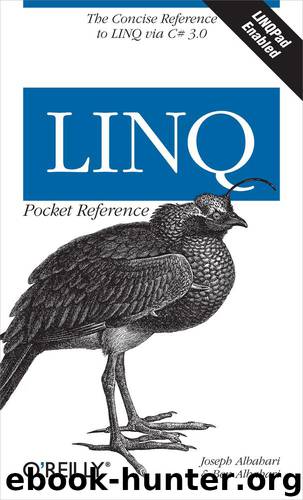LINQ Pocket Reference: Learn and Implement LINQ for .NET Applications (Pocket Reference (O'Reilly)) by Joseph Albahari & Ben Albahari

Author:Joseph Albahari & Ben Albahari [Albahari, Joseph]
Language: eng
Format: epub
Tags: COMPUTERS / Programming Languages / Visual BASIC
ISBN: 9780596558390
Publisher: O'Reilly Media
Published: 2008-02-25T18:30:00+00:00
Joining in lambda syntax
The following comprehension syntax join:
from c in customers join p in purchases on c.ID equals p.CustomerID select new { c.Name, p.Description, p.Price };
in lambda syntax is as follows:
customers.Join ( // outer collection purchases, // inner collection c => c.ID, // outer key selector p => p.CustomerID, // inner key selector (c, p) => new // result selector { c.Name, p.Description, p.Price } );
The result selector expression at the end creates each element in the output sequence. If you have additional clauses prior to projecting, such as orderby in this example:
from c in customers join p in purchases on c.ID equals p.CustomerID orderby p.Price select c.Name + " bought a " + p.Description;
you must manufacture a temporary anonymous type in the result selector in lambda syntax. This keeps both c and p in scope following the join:
customers.Join ( // outer collection purchases, // inner collection c => c.ID, // outer key selector p => p.CustomerID, // inner key selector (c, p) => new { c, p } ) // result selector .OrderBy (x => x.p.Price) .Select (x => x.c.Name + " bought a " + x.p.Description);
Comprehension syntax is usually preferable when joining; it’s less fiddly.
Download
This site does not store any files on its server. We only index and link to content provided by other sites. Please contact the content providers to delete copyright contents if any and email us, we'll remove relevant links or contents immediately.
| Coding Theory | Localization |
| Logic | Object-Oriented Design |
| Performance Optimization | Quality Control |
| Reengineering | Robohelp |
| Software Development | Software Reuse |
| Structured Design | Testing |
| Tools | UML |
Deep Learning with Python by François Chollet(12969)
Hello! Python by Anthony Briggs(10213)
The Mikado Method by Ola Ellnestam Daniel Brolund(10119)
OCA Java SE 8 Programmer I Certification Guide by Mala Gupta(10057)
Dependency Injection in .NET by Mark Seemann(9595)
Algorithms of the Intelligent Web by Haralambos Marmanis;Dmitry Babenko(8606)
Becoming a Dynamics 365 Finance and Supply Chain Solution Architect by Brent Dawson(7957)
Grails in Action by Glen Smith Peter Ledbrook(7949)
Test-Driven iOS Development with Swift 4 by Dominik Hauser(7915)
The Well-Grounded Java Developer by Benjamin J. Evans Martijn Verburg(7851)
Microservices with Go by Alexander Shuiskov(7722)
Practical Design Patterns for Java Developers by Miroslav Wengner(7613)
Test Automation Engineering Handbook by Manikandan Sambamurthy(7559)
Angular Projects - Third Edition by Aristeidis Bampakos(7039)
Secrets of the JavaScript Ninja by John Resig Bear Bibeault(6753)
The Art of Crafting User Stories by The Art of Crafting User Stories(6492)
NetSuite for Consultants - Second Edition by Peter Ries(6431)
Demystifying Cryptography with OpenSSL 3.0 by Alexei Khlebnikov(6224)
Kotlin in Action by Dmitry Jemerov(5376)
